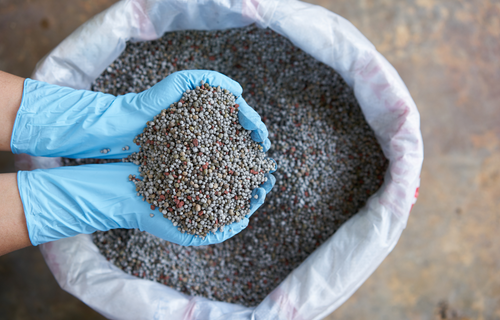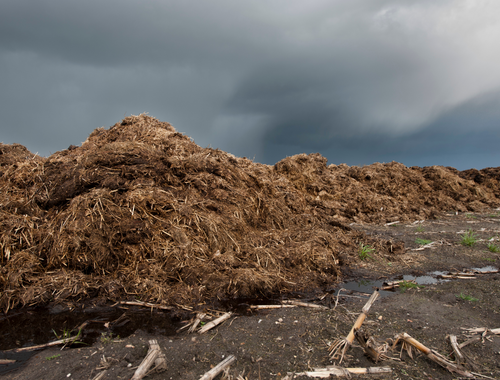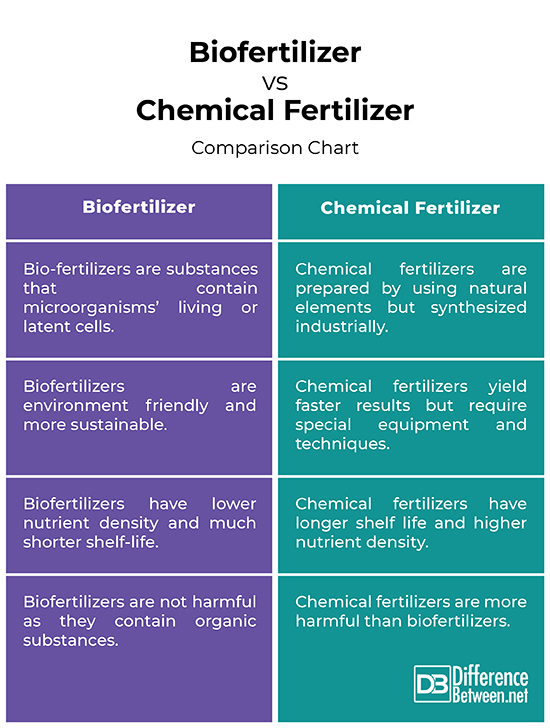Difference Between Biofertilizer and Chemical Fertilizer
Just like humans and animals need nutrients for energy for the full range of physical and mental activities, plants essentially need nutrients for the same reasons. Plants need them to grow, fight off diseases and pests, and so on. Plants get their nutrients from the soil. In fact, soil is a major source of nutrients required for growth. The three important nutrients are nitrogen, potassium, and phosphorus. But nutrient content gradually decreases with continuous farming. So, how do you send those nutrients back to the soil? The answer is simple; by adding fertilizers. And fertilizers can be obtained either naturally or prepared artificially.

Chemical Fertilizer
Fertilizers can be classified into chemical fertilizers and bio-fertilizers depending on the contents and types of materials used to supplement the growth of plants. Chemical fertilizers, also known as synthetic fertilizers, are chemical based substances that are prepared by using natural elements by making them undergo chemical changes in factories. These are synthesized industrially and contain one or more essential nutrients for improving growth of plants, thereby increasing the productivity of the crops. This results in bigger, healthier, and faster yield of crops. Unlike biofertlizers, chemical based fertilizers are extracted and highly refined. Simply put, these are basically inorganic substances that are being added to the soil to sustain plant growth.

Biofertilizer
Biofertilizers, often known as microbial fertilizers or microbial inoculants, are substances that contain microorganisms’ living or latent cells which, when added to the seeds, plant surfaces, or soil, enrich the soil fertility and promote plant growth. Biofertilizers basically increase the nutrients of host plants by increasing the content of the soil. They are mostly preferred over chemical fertilizers because they are environment friendly, cause less pollution, and above all, do not allow pathogens to flourish. Biofertilizers may contain nitrogen fixing microbes or phosphate soluble microbes or spores of VAM fungi. These are supplied to soil by seed treatment or spreading it over the field during cultivation. Simply put, biofertilizers are used to improve the fertility of the land using biological wastes, hence the name.
Difference between Biofertilizer and Chemical Fertilizer
Type
– Fertilizers can be classified into bio- fertilizers and chemical fertilizers depending on the kinds of substances being applied to soil to supply one or more nutrients essential for the growth of plants. Bio-fertilizers are substances that contain microorganisms’ living or latent cells which, when added to the seeds, plant surfaces, or soil, enrich the soil fertility and promote plant growth. Chemical fertilizers, on the other hand, are chemical based substances that are prepared by using natural elements by making them undergo chemical changes in factories.
Composition
– Bio-fertilizers may contain nitrogen fixing microbes, potassium solubilizers, phosphate solubilizers, or phosphorous mobilizers, which are applied exclusively on in combination with microbes or spores of VAM fungi. Modern chemical fertilizers are composed of one or more of three essential nutrients – nitrogen, phosphorous, and potassium. These are basically inorganic substances that are synthesized industrially, and are extracted and highly refined, unlike their organic counterparts.
Nutrient Distribution
– Chemical fertilizers contain one or more of the three essential nutrients required for plant growth, all of which are uniformly distributed. Studies suggest equal amount of chemical fertilizer substitutions may result in best crop yield. Hence, these are more expensive. Bio-fertilizers, on the other hand, keep the soil rich in all kind of micro and macro nutrients by managing an unequal distribution of essential nutrients. So, these are not as expensive as their inorganic counterparts.
Effectiveness
– Biofertilizers are supplied to the soil by seed treatment or spreading it over the field during cultivation. Though not harmful as they contain organic substances, biofertilizers take longer than their chemical counterparts for the essential nutrients to reach the plants. Biofertilizers also have lower nutrient density and much shorter shelf-life than chemical fertilizers, which on the other hand, have longer shelf life and higher nutrient density. So, you’d need less chemical fertilizers to get the same results as you would with biofertilizers.
Biofertilizer vs. Chemical Fertilizer: Comparison Chart

It’s true that bio-fertilizers play a significant role in improving the supply of nutrients and crop availability in upland crop production. Bio-fertilizers reduce the use of chemical fertilizers in agriculture and cost of production because these are more environment friendly, sustainable, and biodegradable. But despite so many advantages, many farmers still use chemical fertilizers because they yield better and faster crop, and work faster than their organic counterparts since they dissolve almost instantly in water. Besides their downsides, chemical fertilizers are behind the bulk of global food production and are a preferred choice of farming in many countries.
What is the difference between biofertilizer and organic fertilizer?
Biofertilizers are used to improve the fertility of the land using biological wastes and natural substances that are extracted from plants and animals. Organic fertilizers, as the name suggest, are materials derived from organic sources, like compost, manure, etc.
What is the difference between chemical fertilizer and organic fertilizer?
Chemical fertilizers, unlike organic fertilizers, are inorganic substances of wholly or partially synthetic origin, meaning the fertilizers are synthesized industrially. Organic fertilizers are fertilizers derived from organic means, such as remains of natural organisms.
Why biofertilizers are better than chemical fertilizers?
Bio-fertilizers reduce the use of chemical fertilizers in agriculture and cost of production because these are environment friendly, sustainable, and biodegradable. Chemical fertilizers are pretty much expensive and can cause pollution.
What is an example of chemical fertilizer?
Some of the common examples of chemical fertilizers are ammonium, phosphate, ammonium phosphate, ammonium nitrate, and so on.
What is chemical fertilizer made of?
Chemical fertilizers are chemical compounds mined or isolated from natural sources and are composed of one of more essential nutrients required for the growth of plants.
- Difference Between Caucus and Primary - June 18, 2024
- Difference Between PPO and POS - May 30, 2024
- Difference Between RFID and NFC - May 28, 2024
Search DifferenceBetween.net :
Leave a Response
References :
[0]Panda H. Manufacture of Biofertilizer and Organic Farming. New Delhi, India: Asia Pacific Business Press, 2011. Print
[1]Lewu, F.B., et al. Controlled Release Fertilizers for Sustainable Agriculture. Massachusetts, United States: Academic Press, 2020. Print
[2]Lal, Rattan. Soil and Fertilizers: Managing the Environmental Footprint. Florida, United States: CRC Press, 2020. Print
